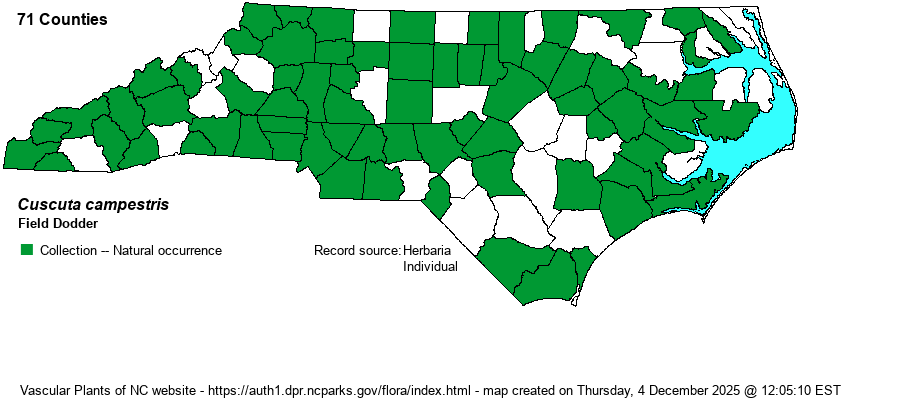| Author | Yuncker | |
| Distribution | Statewide. Though there are collections for only around 70 counties, it seems likely that it occurs in all 100 counties. In general, iNaturalist photos are not used for populating the Cuscuta maps on the website owing to difficulty of identification from photos.
The species ranges over nearly the entire continent. The original distribution is unclear, according to Weakley (2018).
| |
| Abundance | Frequent to common throughout, though perhaps less common in the Coastal Plain. | |
| Habitat | This species occurs in open country -- in fields, roadsides, powerline clearings, and other sunny and disturbed places. It especially grows over legumes, particularly cultivated ones. | |
| Phenology | Flowers from late May to frost; and fruits shortly after flowering. | |
| Identification | See the Taxonomic Comments. The description of the very similar C. pentagona, from Gleason (1952): "Flowers 1.5-2 mm. long, short-pediceled in loose clusters. Calyx about as long as the corolla-tube, its lobes very broadly ovate or depressed, often broader than long. Corolla-lobes usually spreading, about equaling the broad tube, the acute tips often inflexed." That reference included C. campestris within this species, and thus Weakley (2018) separates these two similar species, as follows: C. campestris -- "Flowers 1.5-3.0 mm long, at least some exceeding 2.5 mm long; calyx lobes not overlapping at the base in older flowers, and therefore the flowers not pronouncedly 5-angled"; versus C. pentagona -- Flowers 0.9-2.5 mm long; calyx lobes strongly overlapping and forming definite angles at the sinunes, thus the flower strongly 4-5-angled". | |
| Taxonomic Comments | A few references included this species within Cuscuta pentagona.
The species of Cuscuta all share a few similar features, and they are difficult to separate except by mostly small characters, best seen with a hand lens or microscope. Each is a parasitic vine, lacking roots or true leaves, and nearly all are orange or yellow in color, twining up its host plant with the use of tiny aerial "roots". The small white flowers are in clusters along the stem. These plants should be quite familiar as a group, often presenting a tangled mass of orange vines growing over other plants. See Weakley (2018) or other references for keys to assist in identification. | |
| Other Common Name(s) | Prairie Dodder | |
| State Rank | S5 | |
| Global Rank | G5 | |
| State Status | | |
| US Status | | |
| USACE-agcp | | |
| USACE-emp | | |

